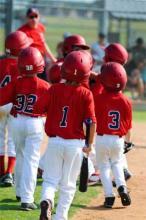
Team sports are organized games governed by a set of rules that are recognized and interpreted by an official governing body as the standard for play.1 The top team sports for children ages 6 through 17 are basketball, baseball, soccer, football, and volleyball. About 20 million American children play organized out-of-school sports with about 25 million playing competitive school sports.2 In the last decade there has been a dramatic increase in the number of children involved in organized sports, especially girls. However, as girls enter adolescence, their participation in sports generally declines.3 By the age of 13, seventy percent of all children drop out of organized sports.4
Participating in sports can have a healthy developmental impact on children. Sports activities promote cooperative play, teamwork, and good sportsmanship. Children can experience acceptance by others and develop social skills in getting along with their teammates. Learning how to play fair and to be a good sport are important lessons that a child can gain through sports.5 Sports provide feedback to children about what it feels like to participate, win, lose, and be fair. They give perspective to face other struggles in life outside of sports and teach how to cope with adversity, even when the odds seem insurmountable.6
Children learn the value of the time and effort, practice, and self-discipline required to play a team sport. They gain many physical benefits from the exercise and motor skill building that is developed from playing a sport.7 Sports help children understand what their own physical talents are.8
There are other advantages to children from participating in sports. Children learn to think critically and solve problems, build self-discipline, develop trust and respect for others, and develop coping skills. These form the foundation for character building. Participating in sports has also been shown to improve academic performance, lower school dropout rates, and deter delinquency. Psychologically, sports can reduce anxiety and depression and enhance self-esteem.9
Organized sports differ from spontaneous child play, because they are more structured, impose rules with authority figures to enforce them, and are competitive.10 The imagination and self-motivation of unstructured free play may be reduced in time and opportunity as children move into playing sports.11 Children should not begin to participate in organized sports before the age of six. It is important that children choose their own sports and that the participation in them is enjoyable. Skill building and teamwork should be more important than winning the game.12 Overemphasis on winning and competition can cause stress from criticisms from coaches, parents, and teammates. Children can also incur injuries from playing sports.13
- 1. Gallahue, David L. and Frances Cleland Donnelly. Developmental Physical Education for All Children. 4th ed. Champaign, IL: Human Kinetics. 2003. p. 366.
- 2. Engle, Marianne. “Sports and Kids: Pathway to Healthy Development or to Unhealthy Competition?” Education.com. < http://www.education.com/reference/article/Ref_Sports_Kids_Pathway/ > 29 Oct. 2010.
- 3. Blume, L. B. and M. J. Zembar. “Sports Participation.” Education.com. < http://www.education.com/reference/article/sports-participation/ > 29 Oct. 2010.
- 4. Op. cit., Engle.
- 5. Dowd, Jennifer. “The Amazing Benefits of Sports for Kids.” Kaboose.com. < http://health.kaboose.com/active-kids/the-amazing-benefits-of-sports-for-kids.html > 29 Oct. 2010.
- 6. Brown, Stuart with Christopher Vaughan. Play. How It Shapes the Brain, Opens the Imagination, and Invigorates the Soul. New York, NY: Avery, Penguin Group. 2009. pp. 115, 117.
- 7. Op. cit., Blume, Zembar.
- 8. Op. cit., Brown, Vaughan.
- 9. Op. cit., Engle.
- 10. Frost, Joe L., Sue Wortham, Stuart Reifel. Play and Child Development. Upper Saddle River, NJ: Prentice-Hall, Inc., 2001. p. 95.
- 11. Op. cit., Blume, Zembar.
- 12. Op. cit., Engle.
- 13. Op. cit., Blume, Zembar.

